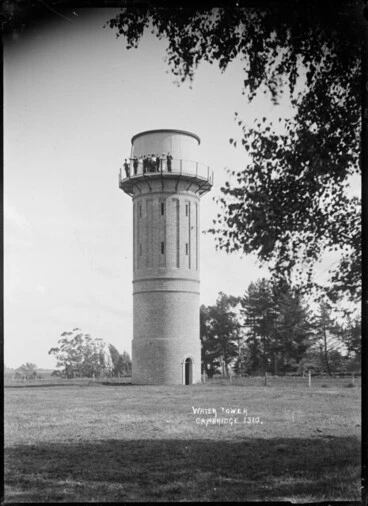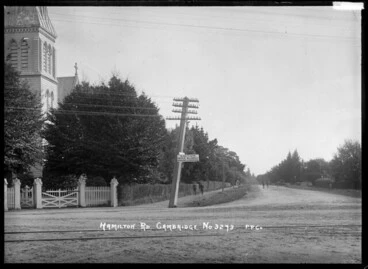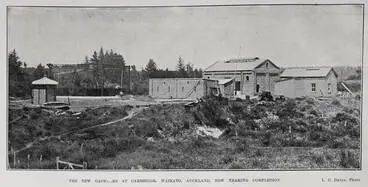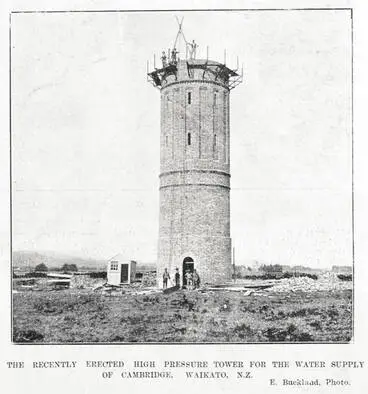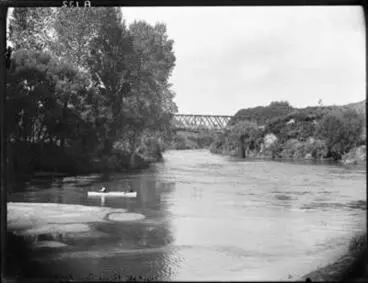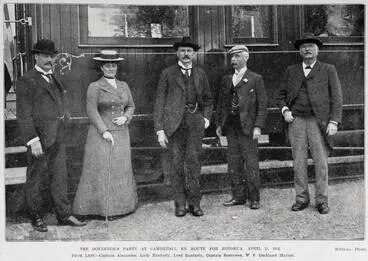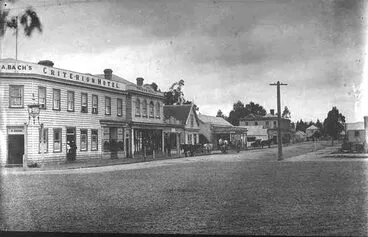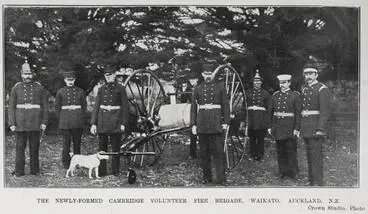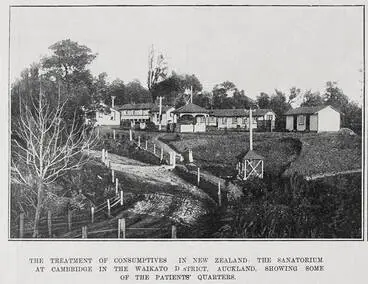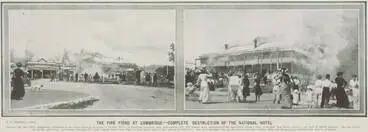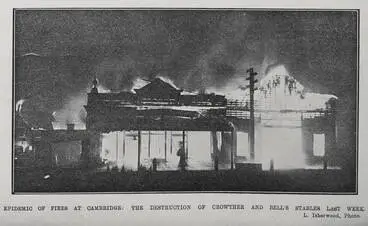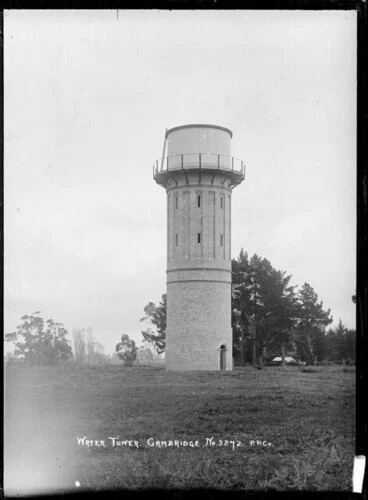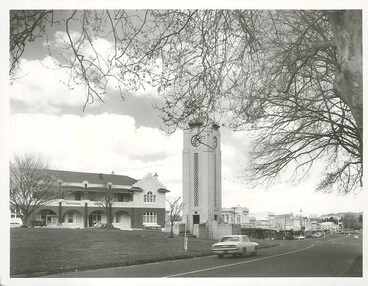Cambridge Tower & Darkie the horse
A DigitalNZ Story by Zokoroa
The Cambridge Water Tower built in 1902/03 is a local icon and landmark. The 24m high cylindrical tower was constructed with the aid of an old black horse called Darkie which helped haul bricks to the top.
Cambridge, Water, Tower, Water Tower, Horses, History, Tucker, Morse
Iconic Water Tower:
When you drive along the outskirts of Cambridge, you will see a round brick tower on the Hamilton Road. It stands in front of the Resthaven retirement village on the Payne Park recreation reserve. Heritage New Zealand gives a detailed history about the Water Tower which opened in 1903 and supplied the Cambridge township with water until c.1926. As a young child I recall on seeing the Tower for the first time being told that a relative had helped to build it, to my delight!
Water Tower is 21m round & 24m high, & operated from 1903 - c.1926
The Tower is supported by a lower wall over 0.5m thick & is topped by a brick-lined metal tank with a lead roof
Alexander Turnbull Library
Tower is on Hamilton Road (SH1) which runs past St Andrew's Anglican Church
The Church is on the left hand corner at the intersection of Hamilton Road and Victoria Street
Alexander Turnbull Library
The Tower stands in front of Resthaven retirement village which opened in 1972
The Tower is behind the row of trees and near the corner of Hamilton Road & Vogel Street. (Aerial photo taken in 1980.)
Alexander Turnbull Library
DARKIE THE HORSE:
The Heritage New Zealand: Water Tower web page mentions the Tower was built with the help of an old black horse named Darkie which was owned by Robert Morse. Darkie was used by William George Tucker to raise bricks by pulley to the top of the 24 metre Tower. Furthermore, "It was said that school children regularly visited the building site, slowing the work by feeding apples to Darkie, which was frustrating for Robert Morse." Reading that information was an 'Aha!" moment - William Tucker was our great grandfather. An account of the Tucker family and other families settling in Cambridge can be found on the Cambridge Museum's website.
Helpers included Robert Morse, his son William, & horse 'Darkie' used by William George Tucker to raise bricks by pulley
Pumped water was stored in the Tower's 20,000-gallon tank, with additional 10,000 gallons in a reservoir by the springs
Alexander Turnbull Library
Who helped Construct the Water Tower:
Mayor William F. Buckland kept a list of the costs and the names of the people and firms involved in the project. Ashley John Hunter (1854-1932), an Auckland civil engineer, carried out the surveying work (£22) and the engineering (approximately £220). (See biographical information: Engineering New Zealand and Wikipedia) Mr J.J. Holland of Auckland was contracted to build the Water Tower, the dam at the springs, the bed for the engine and extras for £1288 3s 3d. The Chief Engineer was F.C. Bunyard who worked 21 weeks on the project for a total cost of £63. (Source: Heritage New Zealand: Water Tower - Additional information)
Mr F. W. Bunyard appointed as engineer from 19 applicants (3 Oct 1902)
Tenders also accepted for building a six-roomed cottage for the new engineer and laying the mains
National Library of New Zealand
Others not listed "who may have been 'outside labour' at a cost of £710s, or they may have been employees or subcontractors" were: Hamilton bricklayer George Russell Fellows, and Robert Morse and his son Bill, who was training as a carpenter under his father's guidance. Various sources also indicate that other helpers included William (Bill) George Tucker, labourers Thomas Vickers and Arthur Davies, and builder Robert Sander. (Source: Heritage New Zealand: Water Tower - Additional information)
A pump was installed at the south end of Queen Street in an engine room at what later became the Municipal Gas Works
The gas driven Tangye's Vertical Treble Ram Pump could handle at least 5,000 gallons per hour.
Auckland Libraries
Materials used:
Heritage New Zealand provides the following description: "Constructed with handmade bricks, the 21 meter circular structure dwarfs other buildings in the town at a height of 24 metres supported by a lower wall over half a metre thick. The bricks were laid in the English bond pattern, renowned for its strength, with decorative features that included a regular pattern of bluestone topped ventilation windows and several horizontal rows of brick dentil pattern. The tower is topped by a brick-lined metal tank topped by a lead roof that held 90922 litres (20,000 gallons): a volume intended to cater for the town's growth." The tank at the top of the Water Tower was used to increase water pressure - every 10.2cm of elevation produces 1 kilo pascal (0.145psi) of pressure.
Handmade brick with letters 'WT'
"One brick has the letters 'WT' in it in a serif font... If the bricks were made locally, there is a chance that 'WT' could stand for 'water tower', to identify the consignment, or perhaps the letters were carved in a green brick by a mischievous young William Tucker, the only worker we know of on site with those initials. Who ever it was incised the letters they had a steady hand and good attention to detail to achieve the serifs on the letters." (Source: Heritage New Zealand: Water Tower - Additional information)
Water Tower construction underway with handmade bricks (Sept 1902)
Ashley Hunter was the surveyor & engineer, J J Holland the contractor, & George Russell Fellows the bricklayer.
Auckland Libraries
THE JOURNEY FOR THE CAMBRIDGE WATERWORKS:
Cambridge was a colonial military outpost established in 1864 by the 3rd Waikato Militia on Ngāti Raukawa (Waikato) land. In July 1864 the Star Redoubt was built on the ground where the Cambridge Museum now stands. By 1867 the population numbered 200 men, women and children. The first local body was the Cambridge North Highway Board in 1871. (Source: Cambridge Museum and Wikipedia: Cambridge, New Zealand.)
INITIAL OPTIONS EXPLORED FOR OBTAINING WATER:
Public meetings about developing a municipal water supply began in the early 1880s, which were reported in the Waikato Times newspaper.
April 1881: Water from springs near the Church of England proposed by Mr John Gwynneth
Estimated cost was £3,000
National Library of New Zealand
27 June 1881: Water from deep brick well at Hally's Brewery proposed
The well was considered as an option as it "had a fair supply of water" to extinguish a fire at the Brewery
National Library of New Zealand
Cambridge becoming a town district (1882):
Cambridge was created a town district in 1882. The merits of Cambridge supporting Parliament's draft Town Districts Bill 1881 were debated at a lively meeting held by the ratepayers and the Cambridge Town Board on 16 July 1881. Several ratepayers saw that Cambridge becoming a town would give more power for implementing an adequate water supply scheme. Others were concerned that becoming a town would lead to more taxation. However, Clause 253 of the Municipal Corporations Act, states no one can be made liable to pay water rates, " unless his property, dwelling, or place of business is situate within 100 yards of any part of the waterworks, and to those situated within the distance specified but who do not elect to take the water only half rates”. (See Waikato Times, 25 June 1881)
14 June 1881: Cambridge Town Board proposed public meeting on Town Districts Bill
Chair Mr J. P. Campbell said if the Bill was passed he'd instance the Water Scheme as too much time been spent on talk
National Library of New Zealand
16 June 1881: Ratepayers debated merits of Town Districts Bill and the implications for a water scheme & extra taxes
National Library of New Zealand
INITIAL OPTIONS EXPLORED FOR OBTAINING WATER:
Waikato River considered as an option
Auckland War Memorial Museum Tāmaki Paenga Hira
7 Oct 1882: Water from the Waikato River proposed to new Cambridge Town Board by Mr G. F. Hosking (town engineer)
Following a spell of dry weather, water tanks were empty and ratepayers had urged for a water scheme
National Library of New Zealand
16 Dec 1882: The springs at Moon Creek on the Domain Board land that he leased were suggested by William Moon
Site visited by Chairman Thomas Wells & Hosking, and both supported proposal. Board agreed ratepayers to be consulted.
National Library of New Zealand
Devastating fires increased public demand:
1 Feb 1883: Public meeting to discuss water supply scheme
Town Board Chair Mr T. Wells outlined the proposed water scheme & subsequent discussions were detailed in the newspaper
National Library of New Zealand
8 Sept 1883: Mr Moon reiterated his allotments were in such a condition he could supply the town with water if desirable
National Library of New Zealand
3 Nov 1883: A fire caused £16,000 damage to four buildings, of which half covered by insurance
Fire destroyed Brown's furniture warehouse, Fretwell's horse-shoeing & plumbers, Hitchins' shoemaking & Arnahold's house
National Library of New Zealand
Cambridge becoming a Borough Council (19 Aug 1886):
8 March 1886: Proposal to become a Council Borough supported at a public meeting as Town Council was "being asleep"
After another fire the night before, it was felt they'd "enjoy a higher rank" for obtaining a "water supply, gas &c"
National Library of New Zealand
April 1886: Discussion on water supply continues
Article states, "Many who were formerly opposed to the scheme are now in its favour" due to recent fires
National Library of New Zealand
9 March 1889: A fire destroyed 20 shops and houses
The town did not have fire appliances and nearly all the water tanks were empty due to the dry season
National Library of New Zealand
15 March 1898: Petition from 48 ratepayers urging necessity of a water supply received by Mayor Arthur Bach
Petition favourably received by Bach (appointed 1895-1898) & the Borough Councillors referred it to a special Committee
National Library of New Zealand
further water options debated (1900):
When William F. Buckland became Mayor in 1898, he initially opposed using the Waikato River and the Moon's Creek supply, preferring to use water from the Maungakawa hills. However, the springs at Moon Creek were deemed the best proposition of the sites the Council had inspected. In November 1901, a sample of the Moon Spring water was sent to the Department of Public Health in Auckland for analysis. Mr J. A. Pond, the Colonial Analyst advised. 'This is soft water of great purity, and will rightly be classed as first class potable water." (Source: Heritage New Zealand: Water Tower)
19 Feb 1900: Mayor Buckland told Borough Council he does not think a supply from the Waikato River would be desirable
Deterrents were the pumping costs & the water not as good as what would be brought direct from the Maungakawa hills.
National Library of New Zealand
6 July 1900: Mayor Buckland explained at a public meeting the intent to bring water from the Maungakawa hills
A reservoir was to be built to store the water & a dam built across the valley into which 3 streams could be diverted
National Library of New Zealand
31 May 1900: Borough Council agreed to poll ratepayers on Maungakawa proposal
Proposed borrowing £6000 for a gravitation water supply from Maungakawa
National Library of New Zealand
Map showing location of Cambridge, the Waikato River and Maungakawa hills
Manatū Taonga, the Ministry for Culture and Heritage
27 Sept 1900: Borough Council received several communications from civil engineers wanting to supply water
National Library of New Zealand
Winning option - Moon Creek spring (1901):
June 1901: Waterworks Committee supported civil engineer Ashley John Hunter's latest scheme to use the Moon Creek Spring
Scheme was to pump the water from a spring on No. 3 Domain section to a reservoir
National Library of New Zealand
June 1901: Borough Council proposed raising loan of £6000
National Library of New Zealand
Oct 1901: Ratepayers poll held
National Library of New Zealand
Water supply project approved (1902):
When issues such as finalising the water source, costs and ratepayers' support were sorted, the project proceeded in 1902 during Buckland's first period as Mayor (1898-1903). At this time the town's population had reached over 1000. It was calculated that the Water Tower would supply a population of 3000.
Mayor Buckland (on right) supported the water project during his first term as Mayor (1898-1903)
Auckland Libraries
The NZ Herald (4 Feb 1902) stated, "The Waterworks Committee reported that the scheme for supplying the borough with water was in a forward state, and the loan of £6000 was now at the Council's disposal. The engineer (Mr. Ashley Hunter) had submitted four schemes, varying in price according to the size of.pipes. The committee favoured scheme No. 1, providing for "Acme" pipes, at an estimated cost of £5562, which included practically everything, required in connection with the water scheme. A satisfactory- reply was -received from the Treasury relative to the handing over of the loan money. " (Source: Papers Past)
Government announced a loan of £6OOO for waterworks (9 Jan 1902)
National Library of New Zealand
Borough Council received initial £3000 from the Govt (29 May 1902)
National Library of New Zealand
Tenders received (March - May 1902):
Tenders were called by the Borough Council in March 1902 for submission by 2 May 1902. Successful was J.J Holland's tender of £1077 to build the tower. A cheaper tender by W. Souter and Co. for an American steel tower was rejected as that tower was not tall enough and would require considerable upkeep costs for painting etc. The town belt land the Tower was situated on - allotments 2,3,4,5 and 6 - were leased from the Crown by the Borough of Cambridge on 25 June 1903. (Source: Heritage New Zealand)
Borough Council opened tenders for the supply of water pipes (12 March 1902)
National Library of New Zealand
Advert for tenders for the construction of 20,000 gallon Water Tower, 75ft high, in brick and iron
National Library of New Zealand
Tenders accepted (2 May 1902) including J.J. Holland's to build the Tower (£1077)
Also accepted: Davys and Son (Cambridge) for erecting the engine & boiler house, & Chambers and Son for pump & boiler
National Library of New Zealand
Another benefit of having a water supply would be a decrease in insurance rates
Captain Field, Inspector to the Auckland Fire Underwriters' Association, visited & advised of lesser insurance rates
National Library of New Zealand
Water tower project completed:
The cost of project was £5974 19s 9d which included "the tower, laying the mains pipes with 100 connections, associated structures and machinery" which included an additional storage reservoir at Moon's springs holding a further 10,000 gallons [45461 litres]; a gas driven Tangye's Vertical Treble Ram Pump which could handle at least 5,000 (22731 litres) gallons per hour, supplemented by an oil driven pump, which handled a further 5,000 gallons (22731 litres) per hour, and was capable of raising the water 200 feet (61 metres). (Source: Heritage New Zealand: Water Tower )
Mayor Buckland announced (27 Feb 1903) waterworks would be completed this week
£50 presented to the Mayor as a show of appreciation. Waterworks Committee was asked to arrange for a formal opening.
National Library of New Zealand
Water Tower officially opened in MArch 1903:
A summary of the newspaper reports is provided by Heritage New Zealand: "Despite inclement weather, there was a good crowd assembled when Mayor Buckland started the pump before walking to the tower, where the water was turned on, then proceeding to Victoria Street where a hose was attached to a hydrant to demonstrate the water pressure: the water spouted 40 feet (12.2 metres) into the air: Buckland and Hunter were cheered by the crowd."
Water Tower officially opened on 11 March 1903
The public gathered at the pumping-station where the Mayor turned on the switch at 3pm
National Library of New Zealand
After the public gathering, champagne flowed at the Criterion Hotel, with toasts by Mayor Wiliam Buckland
Auckland Libraries
Fire Brigade formed & Plumbing firms expanded:
The springs produced approximately 125,000 gallons (568262 litres) each day. The consistency of supply of water was instrumental in the Cambridge Volunteer Fire Brigade being formed in 1904. In addition, plumbing firms in the Waikato increasingly advertised their services to households and businesses to connect to the water supply. (See examples of advertisements in Papers Past by W. R. McVeagh and John E. Hammond)
Duties of Borough Engineer added to Waterworks Engineer (28 May 1903)
The recommendtion was made by the Works Committee and accepted by the Borough Council
National Library of New Zealand
Waterworks accounts require extra funding from Government to balance books (18 June 1903)
Council resolved to ask for an extra £300 on top of the £6000 loan
National Library of New Zealand
Borough Council resolved to ask for an extra loan of £500 to get an auxiliary punt and engine (30 July 1903)
Treasury advised this could be requested under Local Bodies Loan Act, 1901
National Library of New Zealand
A telephone to connect the Borough Council office, pumping-station, and engineer's cottage (27 Nov 1903)
A wafer-cart also to be obtained if business people pay for watering the streets.
National Library of New Zealand
Consistency of water supply led to Volunteer Fire Brigade being formed (1904)
The Brigade's first call was to a chimney fire at Masonic Hotel (18 Aug 1904)
Auckland Libraries
Population growth & PEAK periods of Water usage (1910):
By 1910, the population of Cambridge had reached approximately 1400. A report presented by the Borough Engineer at a Council meeting noted that there were three peak periods of water usage each day. If a fire occurred during those peak times, the system would run short of water. As a solution, Mayor Buckland proposed purchasing land adjoining the waterworks from John Sharp at a cost of £200 to secure an additional spring of water. This was eventually approved by Council and a 10,000 gallon (45460.9 litres) storage reservoir was built. (See Papers Past and Heritage New Zealand: Water Tower)
Fire at Webb boiling-down works (19 Jan 1910)
National Library of New Zealand
Improved Water supply essential for health purposes:
Cambridge increasingly seen as a health sanatorium
National Library of New Zealand
EXTRA WATER PRESSURE NEEDED FOR FIREFIGHTING (1912-1913)
A series of fires reported in newspapers showed that Cambridge’s water supply also required extra pressure for firefighting purposes. A gravitational scheme was proposed, but Councillor Wells told a council meeting that it was not possible to raise the necessary loan of £30,000. Instead, £4000 might be raised to pay for another water tower in the centre of town. In September 1913, the council agreed to borrow £8000 for a new water tower, which would not only increase pressure for firefighting but also extend mains coverage to most of the Cambridge residents. (Source: Waikato Times: Memory Boxes article by Ann McEwan, 2 July 2012)
National Hotel destroyed by fire on 29 Nov 1912
Auckland Libraries
Seventh Day Adventist training college destroyed by fire (24 Dec 2012)
National Library of New Zealand
Block of buildings wiped out by fire: stables, shops & garage (20 Jan 1913)
National Library of New Zealand
Borough Council again urged to institute a water supply system suitable for firefighting purposes (21 Jan 1913)
"The supply of water proved quite inadequate to deal with the conflagration"
National Library of New Zealand
Water Tower decommissioned c.1926:
Water quality tests were conducted by Mr T. Dix who was the Council engineer from 1923-1937. The results found the water drawn from the Moon Creek Spring was increasingly polluted. This was attributed to the growth of housing in the area as the town's population grew. The Council agreed to switch to using water from Maungatautari. Preparations began in August 1926 with the laying of new pipes which was scheduled for completion by Christmas. The new waterworks were officially opened by Mayor T. F. Richards. The Water Tower on Hamilton Road was then closed. (Source: Heritage New Zealand and the Cambridge Museum)
The Water Tower was closed in 1926 due to water pollution
Studies had shown the springs the Tower drew water from were being polluted due to new housing nearby
Alexander Turnbull Library
HIstoric status - Tower Part of Cambridge "character"
The Water Tower became a landmark and was featured in a postcard produced by Muir & Moodie Studio in 1909 (see Te Papa). The Tower is part of the character of Cambridge along with other buildings. For example: the St Andrew’s Church, the former Trinity Church (“Pink Church”) on the other side of Victoria Street, the Town Hall, the Town clock, the Post Office and the High Level Bridge. Cambridge was awarded the title New Zealand's Most Beautiful Large Town in October 2019 (see Wikipedia: Cambridge, New Zealand). On 16 Feb 2010, the Tower was listed on the New Zealand Heritage List/Rārangi Kōrero as having an Historic Place Category 2 listing (having historic or cultural significance or value). It is also listed as a Category B structure under the Waipa District Plan (having regional and district-wide significance).
Trinity Presbyterian Church at Cambridge
Alexander Turnbull Library
St Andrew's Church, Cambridge
Alexander Turnbull Library
Lake Street with the Clock Tower and National Hotel
Archives New Zealand Te Rua Mahara o te Kāwanatanga
Cambridge post office
Manatū Taonga, the Ministry for Culture and Heritage
Cambridge town hall
Manatū Taonga, the Ministry for Culture and Heritage
Future of the HISTORIC Water Tower, 2018 -2022:
The Tower's future came under review by the Waipa District Council following the introduction of national guidelines around earthquake-prone buildings. See Cambridge News article, "Water tower under review" (18 March 2018, p.3) by Claire Robson which also describes the Tower's physical condition, including a corroded water tank and steel work.
The outcome was that Heritage NZ has advised that the tank can be removed and a piece of steel steel erected to represent the tank. See Cambridge News article: Mary Anne Gill, ' Work can start on historic sites", (21 Feb 2022): https://digitalnz.org/stories/5dac014e48c13b03064d2029
Further information:
Cambridge Museum's web page"A list of historic buildings".
The Cyclopedia of New Zealand [Auckland Provincial District]: Cambridge includes biographical information about the Mayors and Councillors
Heritage New Zealand: Water Tower: See the information listed under the following headings: Summary and Additional Information which provides a comprehensive historical narrative written by Kathryn Mercer and includes additional reference sources.
McEwan, Ann. "Memory Boxes: Cambridge Tower" Waikato Times (2 July 2012)
Papers Past for newspapers articles about the waterworks and plumbing advertisements
Robson, Claire. "Water tower under review" Cambridge News (18 March 2018, p.3)
